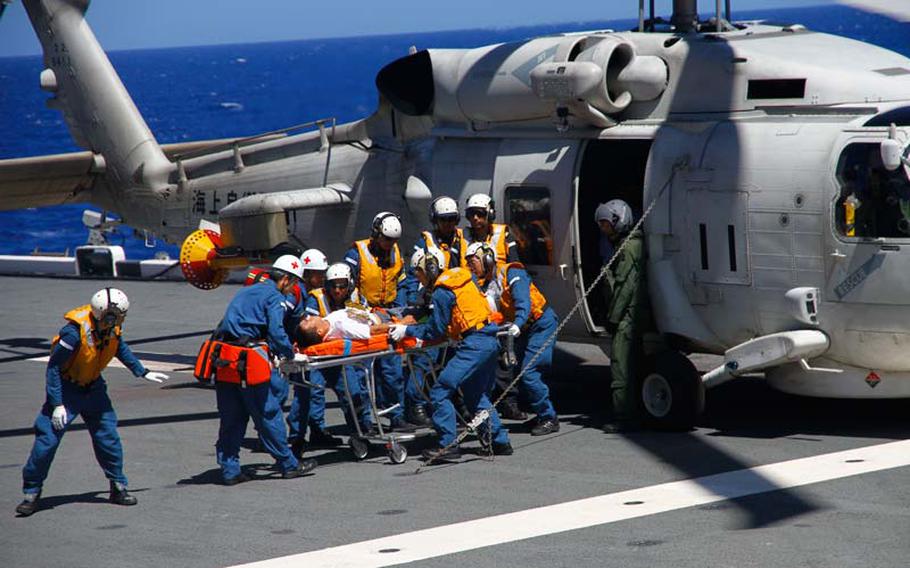Navy
Mock typhoon disaster aims to determine when military should respond
Stars and Stripes July 13, 2014

Sailors on the Japanese destroyer Ise transfer an injured man to a gurney Saturday, July 13, 2014, as part of a mock typhoon disaster drill during the 2014 Rim of the Pacific exercise in Hawaii. The Ise crew practiced procedures for receiving and treating victims of natural disasters. (Wyatt Olson/Stars and Stripes)
ABOARD THE JAPANESE DESTROYER ISE, Hawaii — A major element of the 2014 Rim of the Pacific naval exercises involves training to coordinate international military response to natural disasters in Asia.
Military elements from six nations — America, Australia, New Zealand, Canada, Indonesia and Japan — are conducting a week-long RIMPAC response to a mock typhoon that has hit the fictitious country of Griffon in Southeast Asia.
Some of the troops involved don’t have to imagine what it’s like to respond to a scenario such as this. For example, the Ise was one of three ships Japan deployed to the Philippines last fall in the wake of the devastating Typhoon Haiyan.
The Ise, a destroyer with a large deck for landing helicopters, serves as the maritime headquarters for this year’s relief response exercise for RIMPAC. Japan’s self-defense forces will no doubt play an expanded role in the future for disaster response, but also for regional security: Lawmakers there are in the process of changing laws that could make it easier for Japan’s forces to assist allies in armed conflict.
On Saturday, helicopters arrived on the flight deck of the Ise bearing mock victims of a mass casualty drill. Among the helicopters were several belonging to the U.S. Army — a first for RIMPAC — which posed as aircraft belonging to the typhoon-hit host nation.
The Health Association of Hawaii is using the mass casualty portion of this exercise to certify its disaster-response readiness, said Commodore Kevin Coyne, a U.S. Navy contingency engineer working out of the exercise’s joint task force headquarters on Ford Island in Honolulu.
“They’re going to take 250 patients — full fake cuts and everything — and we’re going to transport by sea, air and land to all five islands and most of their hospitals,” Coyne said. “This is the largest exercise the HAH has ever been part of.”
Also participating in the exercise are numerous non-government agencies, such as Red Cross, along with United Nations agencies.
The “real meat” of the exercise is to test the thresholds at which the host country will need to ask for assistance, Coyne said.
“Can the local government respond?” Coyne said. “Can the UN international clusters respond? If not, that’s when the military comes in. We are the resource of last response.”
The triggers for a military response for such a disaster are twofold, he said.
“Do we have a unique capability that the UN or host nation does not have? Or do we have a capability that we can get to the affected area faster than they do?”
One primary example of that unique capability is logistics — moving supplies into the damaged areas and moving victims out.
The headquarters Coyne is working out of is entirely independent, just as it would be when the military arrives in the midst of an ongoing disaster.
“You have to imagine right now you’re in a country that’s been devastated by a hurricane,” said U.S. Navy Commodore Chris Peterschmidt, who’s in charge of coordinating the side-by-side Japan/U.S. headquarters on Ford Island. “We’re off the grid. We’re not using any cell phone towers. Not using anybody’s water, gas or electricity. We brought it all ourselves. We are entirely self-dependent, and we can do it for about 15 days, with MREs, our own gas.”
That’s gotten a bit easier during this year’s exercise, thanks to the conversion of part of the camp to purely sustainable energy. About 90 percent of the energy used for a camp that could potentially house 264 troops is being operated with solar, wind and hydrogen energy, a project receiving technical advice from the U.S. Army Corps of Engineers.
The roar of diesel generators filled the air in the headquarters portion of the makeshift camp this week, but the part powered by renewable energy was tranquil.
“If you’d been here a year ago and had an exercise like this, we’d be yelling at each other now because of the generator noise,” said Sgt. Jeremy Nissly with the Corps of Engineers. “We’re doing the same mission right now, and it’s peace and quiet. We have almost no emissions at this point, and our costs are very low.”
He added: “We don’t have to worry about when the next convoy’s coming with fuel.”
Asked whether the camp had to make any compromises to go mostly renewable, Nissly said that the demonstration camp actually had experienced unexpected benefits. For example, a large, solar-topped tent was placed over a regular canvas tent. As a result, while the outside tent converted the sun’s heat to energy, it also prevented the rays from penetrating the lower tent, keeping it cooler.
But testing this kind of technology is a fringe benefit of RIMPAC, not its greater purpose.
“As enamored as I am about the equipment and the hardware, what’s more important — and this is what RIMPAC represents — is the opportunity to practice multinational cooperation in a controlled environment … practice communicating with each other, sharing information, sharing resources,” Peterschmidt said.
“That’s really the hard part.”